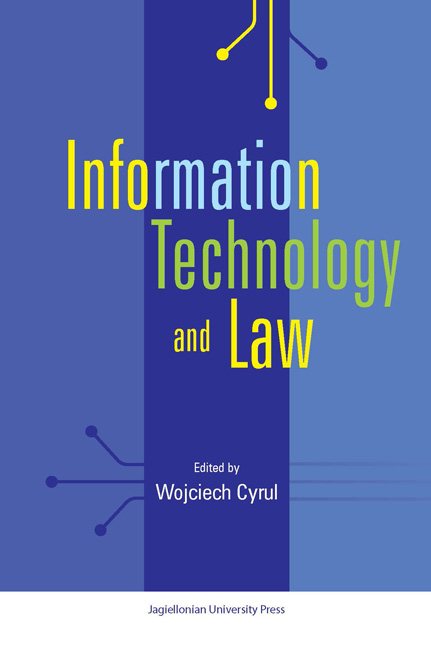Book contents
- Frontmatter
- CONTENTS
- Preface
- Chapter 1 Technological Destabilization of Law
- Chapter 2 Problems with the Storing and Presentation of Information
- Chapter 3 XML Models for Legal Documents: Current Polish Practices and International Standards
- Chapter 4 Similarity Analysis of Polish Legal Documents Using WordNets Semantic Relations
- Chapter 5 Consolidation of Legal Documents in an Electronic Format
- Chapter 6 A Three Dimensional – Code and a Question of the Normative Hyper-linking?
- Chapter 7 The Law, Labour Unions and Information Technology: Enhancing or Restricting Democracy at the Workplace
- Chapter 8 Protection of the Consumer in Digital Content Contracts
- Chapter 9 Procedure, Time and Imputation in Criminal Law
Chapter 6 - A Three Dimensional – Code and a Question of the Normative Hyper-linking?
Published online by Cambridge University Press: 05 December 2014
- Frontmatter
- CONTENTS
- Preface
- Chapter 1 Technological Destabilization of Law
- Chapter 2 Problems with the Storing and Presentation of Information
- Chapter 3 XML Models for Legal Documents: Current Polish Practices and International Standards
- Chapter 4 Similarity Analysis of Polish Legal Documents Using WordNets Semantic Relations
- Chapter 5 Consolidation of Legal Documents in an Electronic Format
- Chapter 6 A Three Dimensional – Code and a Question of the Normative Hyper-linking?
- Chapter 7 The Law, Labour Unions and Information Technology: Enhancing or Restricting Democracy at the Workplace
- Chapter 8 Protection of the Consumer in Digital Content Contracts
- Chapter 9 Procedure, Time and Imputation in Criminal Law
Summary
1. A New Wave of Codifications – sometimes new content, but almost always old form
We are now experiencing in Europe a new wave of codifications. Some of them are like a breath of fresh air; others merely develop or alter existing concepts. Appealing, however, is the reluctance to adopt new structures for the codes. The mode of the presentation of the legal matter remains mostly unaffected. Perhaps the most recent innovation in this field was (and this was more than 20 years ago) the new Dutch Civil Code. At least the system of numbering of the articles facilitates the development and the revisions of the text, albeit the quotation of the provisions is much more difficult. The system of the Dutch Civil Code is also interesting because it endorses a lot of the German tradition of the codification (one must remember that the starting point for the Dutch law is the French Code Civil), but it does not follow the pandectistic structure of the code. Despite all of these innovations, since the pandectistic structure was developed and in reaction to it the anti-pandectistic codes (as a Swiss law) drafted, nothing entirely new has happened which would revolutionize the structure of the codifications.
Whilst the use of technology has also changed the manner of usage of the legal texts immensely, it has not influenced the way in which texts are drafted.
- Type
- Chapter
- Information
- Information Technology and Law , pp. 95 - 102Publisher: Jagiellonian University PressPrint publication year: 2014



